UK: Striped Hawkmoth, F: Sphinx livournien, D: Linienschwärmer; Altweltlicher Linienschwärmer, RUS: Lineichatyi Brazhnik, S: Vitribbade Skymningssvämare, NL: Gestreepte Pijlstaart, CZ: Lišaj vinný, H: sávos szender, E: esfingido de la vid; oruga de esteva; esfinge rayada, PL: Zmrocznik liguryjski, FIN: Juovakiitäjä; Viirukiitäjä, I: sfinge della vita; sfinge livornese, HR: prugasti ljiljak, DK: Hvidribbet aftensværmer, N: Hvitribbet mauresvermer, EST: Joonsuru.
Sphinx livornica Esper, 1780, Die Schmetterlinge 2: 87, 88, 196.Type locality: Italy, [Livorno].
(Taxonomic notes. (i) Hyles lineata (Fabricius, 1775), under which Hyles livornica used to be listed as a subspecies, is a distinct species restricted to the New World (Harbich, 1980a, 1982). The morphological differences between the two have been well documented by Eitschberger & Steiniger (1976). Differences in distribution are reviewed by Haxaire (1993).
(ii) The taxa known as Hyles renneri Danner, Eitschberger & Surholt, 1998, and Hyles livornica tatsienluica (Oberthür, 1916) were found to be conspecific by Hundsdörfer et al. (2017) and distinct from Hyles livornica. They therefore reinstated Hyles tatsienluica as the valid name for this good species, and synonymized H. renneri with it.)[Further details on this species, as well as photos of all stages, can be found on Lepiforum.]
![A plate from Hübner (1796–[1838]). A plate from Hübner (1796–[1838]).](hub1806.jpg)
Palaeotropical (but not rainforest areas of Africa and Asia), Holomediterranean and Saharo-Arabian. Pleistocene refuge: probably the Afrotropical region.
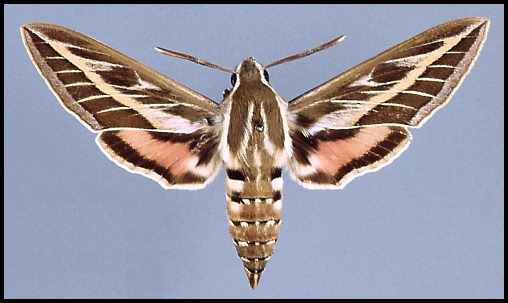
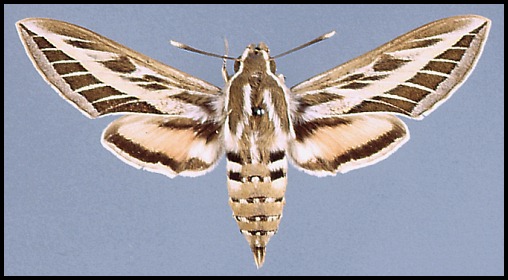
Wingspan: 60--85mm. Forewing costal area pale olive-brown, shaded behind with dark brown, and with a white patch in and another beyond cell; discal band pale yellow, both edges sharply defined; post-discal band brown; marginal band purplish-grey, dotted with black; cilia of outer and inner margin white; veins white. Hindwing crimson, basal area and a broad submarginal band blackish; marginal band narrow, pink dotted with black; a white patch near anal angle. Antenna brown, tip white. Head and thorax olive-green. Palpus white, with a white lateral stripe running from palpus over eye to base of thorax, met by the white upper fringe of the tegula; abdomen pale olive-brown, with black and white side-patches as in Hyles nervosa; fringe of abdominal tergites chequered black and white. Pulvillus present. Outer spines of fore-tarsus prolonged, at least partly, their number often obviously reduced (Bell & Scott, 1937).
In other words, similar to many other species of the genus, but with distinctive, white forewing venation. Although extremely variable in size, with some individuals dwarfing others, it exhibits very little other variation except in the intensity of coloration and degree of pattern. In the southern Sahara, small pale individuals occur (Stauder, 1921a) which are referable to f. saharae (Gehlen, 1932). This is in agreement with Speidel, Hassler, Back & Hassler (1989).
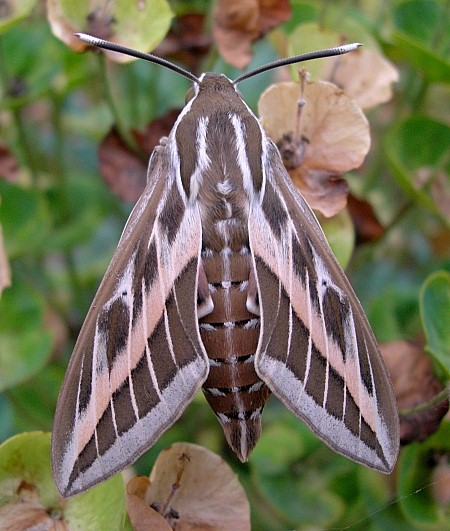
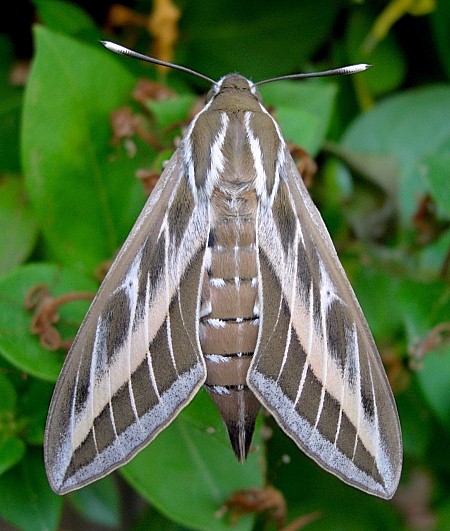
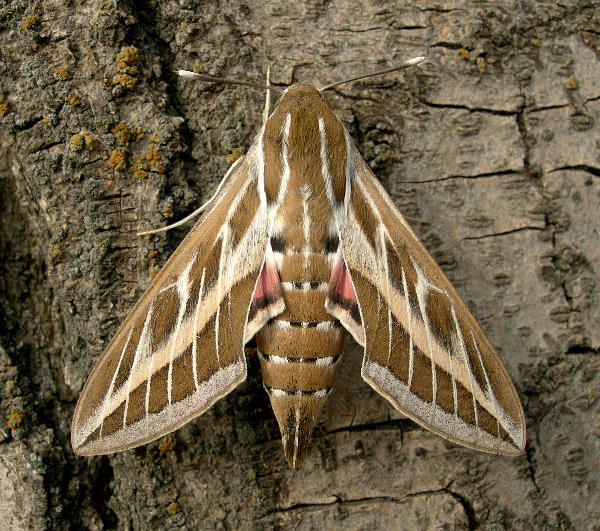
A noted migrant, generally found in open ground with few trees and shrubs, such as rough grazing land, parched hillsides and sand-dunes, or in vineyards. In semi-desert areas, huge numbers can build up during winter and spring, especially after heavy rains.
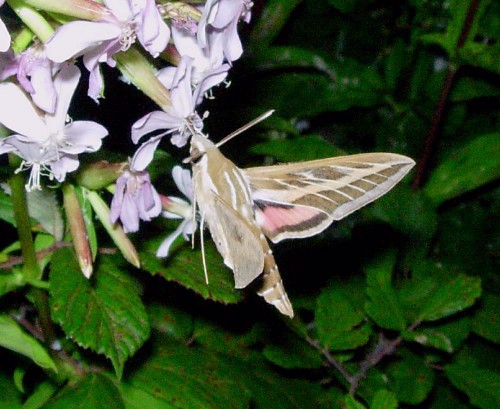
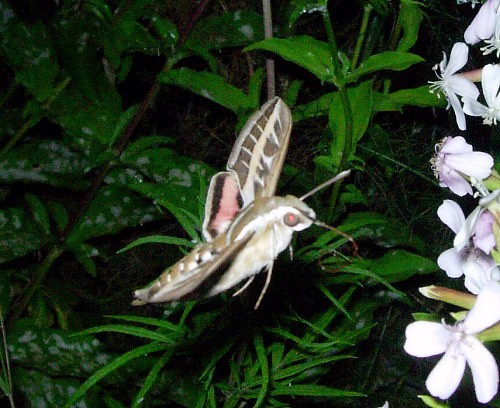
An extremely active species, normally flying towards evening, when considerable numbers are often attracted to sweet-smelling flowers (such as Silene villosa in the Middle East) and to light. Pairing always takes place at dawn over a period of two or three hours. Thereafter, females can cover considerable distances whilst egg-laying. In southern Europe and North Africa, many are also active during daylight hours, especially when on migration. (See also Heinig (1981b).)
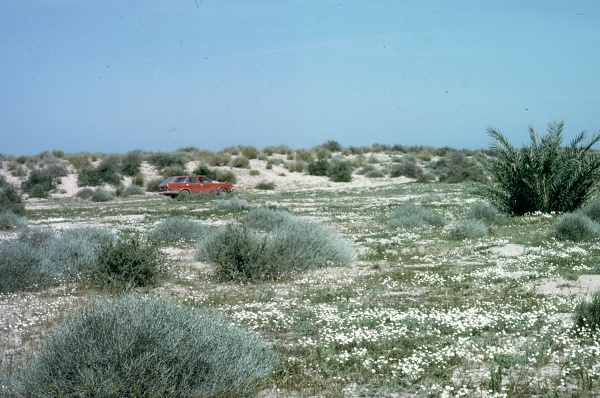
Migrant and multivoltine in its southern range from late February to October, with a peak in March or April. Farther north, migrants and their offspring have been recorded from late May to October. Mass spring emergences often occur after multiple periods of heavy rain.
OVUM: Slightly oval (1.1 x 1.0mm), glossy and pale green. Tiny for the size of moth. Laid on the upper and underside of leaves of the hostplant, with four or five to a small plant.
LARVA: Full-fed, 65--80mm. Polymorphic.
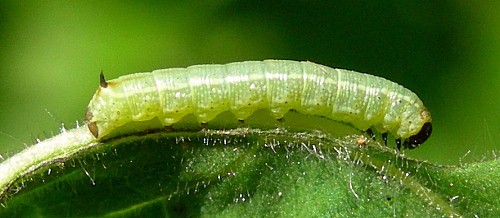
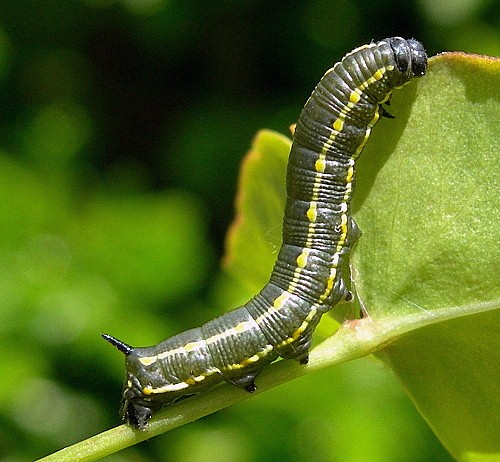
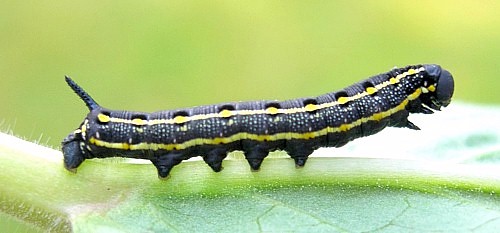
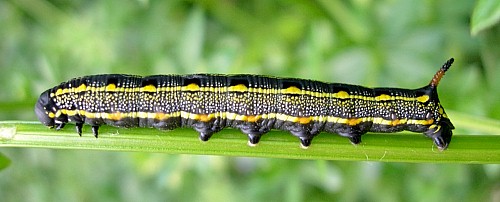
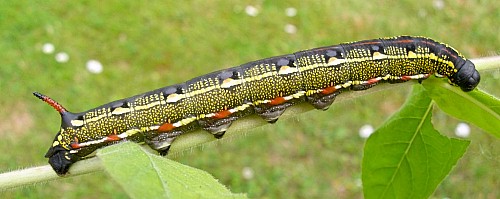
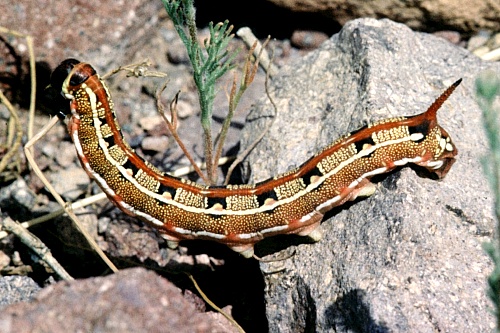
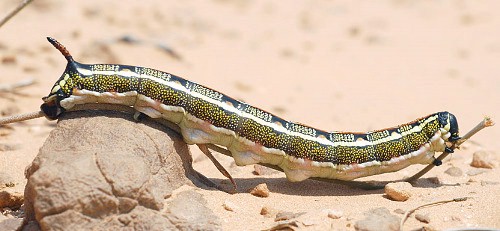
Newly hatched, 4mm long; greenish white, with black head and horn. With feeding, body darkens to olive green; in second instar the final pattern appears, thereafter becoming more brilliant at each moult. In hot, dry areas fully-grown larvae are usually of the colour form depicted above. Some, however, have very extensive black markings (cooler areas); green stripes instead of yellow; and a plum-coloured ventral surface. A very different colour form exists commonly in North Africa, i.e. pale apple-green with yellow eye-spots and speckling (see below).
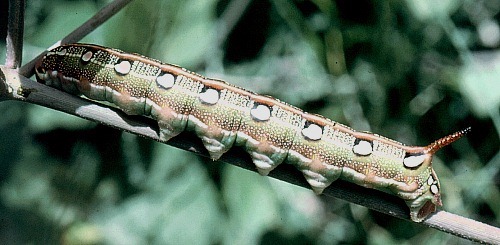
At all stages, larvae feed quite openly on their low-growing hostplants, alternating bouts of frenzied feeding, when large quantities of food are consumed, with spells of basking. When disturbed, young individuals will drop from the plant; older larvae will twitch violently from side to side while regurgitating green digesta. (See also Heinig (1981b).)
Found in North Africa from February until October -- sometimes in hundreds of thousands in semi-desert areas after a winter with good rains; farther north from June until September.
Major Hostplants. Rumex, Polygonum and, in North Africa and the Middle East, the flower- and seed-heads of Asphodelus (Rungs, 1945; Pittaway, 1979b; Rungs, 1981). Rumex vesicarius is a firm favourite in the deserts of Saudi Arabia (Irene Linning, pers. obs, 2014).
It should be noted that during mass occurrences starving larvae can complete their development on a great many species of plants not normally eaten, such as cotton (Gossypium) (Benlloch, 1931).
Minor Hostplants. Vitis, Parthenocissus, Fuchsia, Galium, Antirrhinum, Plantago, Zygophyllum fabago, Emex spinosus, and, in Asia Minor, the flower-heads of Eremurus. It has also been known to feed on various other plants (in gardens and in the wild), including Pelargonium, Boerhavia, Beta, Asparagus, Acacia, Linaria, Cicer, Fagopyrum, Aloe vera (flower-heads), and many others (Durand, 1931). In Libya it has been recorded from Olea europaea, Acacia saligna, Eucalyptus resinifera and Eucalyptus rostrata; however, those feeding on the eucalypts failed to pupate (Jannone, 1966). Olea has also been recorded from Tunisia (Bernard, 1964). Also, in recent years this species has become a minor pest of Arbutus unedo (the strawberry tree) in the Mediterranean area (Jannone, 1966; Scortichini, 1986). It used to be an occasional major pest of grapevines in southern Europe, North Africa and the Middle East during mass migrations (Bredemann, 1919; Delassus, 1923; Guillemenet & Roche, 1957; Mijuskovic & Radulovic, 1960), attacking even the unripe fruits (Bredemann, 1919). Occasionally, it also stripped whole fields of buckwheat (Fagopyrum esculentum) (Zryakovskii, 1930). Recorded from Euphorbia forsskalii and Boerhavia repens in Mauretania.
[Can be reared in captivity on lettuce (Lactuca sativa). If buying from a supermarket during the winter months, use organic produce (Bernie Betts, 2015).]
PUPA: 30--45mm. More elongate than most Hyles species and variable in the amount of brown coloration present, some being yellowish or even translucent. Like others of the genus, encased in a flimsy, silk cocoon amongst ground litter or in a grass tussock. Overwinters as a pupa and may diapause for more than one year.
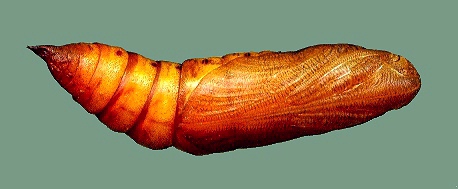
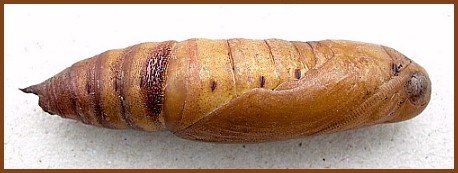
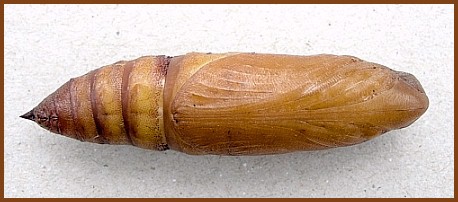
Tachinidae: Chetogena aegyptiaca (Villeneuve, 1923), Drino (Palexorista) imberbis (Wiedemann, 1830), Drino vicina (Zetterstedt, 1849), Exorista sorbillans (Wiedemann, 1830), Nemorilla maculosa (Meigen, 1824).
Occurs throughout the region as a migrant, often in very large numbers, but resident only in the south and rare in the north. Recorded several times from Novosibirsk in western Siberia, Russia (Izerskiy, 1999).
Extra-limital range. Africa to southern India, China and Japan.
Replaced across the Tibetan Plateau, from Nepal north to Gansu, by the very similar high altitude species Hyles tatsienluica (Oberthür, 1916), which was until recently thought to be a subspecies/form (Hundsdörfer et al., 2017).
None. What was 'subsp.' livornicoides (Lucas, 1892) from Australia is a distinct species. (An interesting analysis of the distribution of the lineata/livornica complex is given by Haxaire (1993).)
 Return to species list
Return to species list